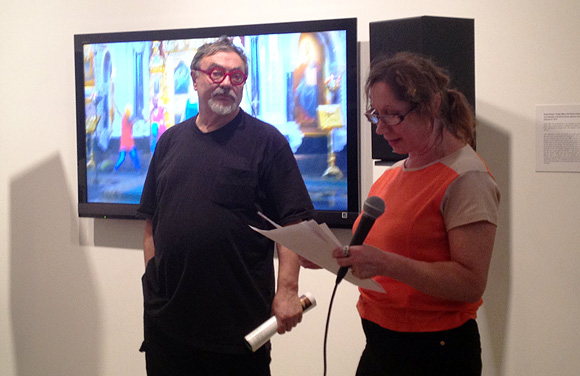On September 10th, a benefit for the Pussy Riot feminist punk band took place in Lombard Freid Gallery in New York. The walls were covered in flat-screen televisions showing five original videos of the band's performances filmed in various locations in Moscow, culminating in their final, and most provocative, act at the Christ the Savior Church. The event, co-sponsored by Amnesty International, attracted a mixed Manhattan crowd of artists, journalists, human rights activists, and band sympathizers.

Suzanne Nossel, executive director of Amnesty International
The benefit provided a discussion platform for members of the contemporary arts community and human rights organizations advocating for the women’s release. As many may recall, on August 17, three Pussy Riot band members (Nadezhda Tolokonnikova, Maria Alyokhina and Yekaterina Samutsevich) were sentenced to two years in prison for their performance in a major Moscow Cathedral. The trial was replete with numerous legal violations, while the disproportionate verdict triggered protests around the world. Institute of Modern Russia has already expressed its unequivocal support for the international campaign to free the three young women.
Suzanne Nossel, executive director of Amnesty International, delivered a powerful speech at the benefit, calling for the girls’ immediate release. She made it clear that Amnesty International considers the members of Pussy Riot to be prisoners of conscience, detained solely for thei peaceful expression of their beliefs. “Sting, Madonna, Red Hot Chilli Peppers, Paul McCartney, along with many others, have all voiced their support for Pussy Riot”, Ms. Nossel said, while highly praising the artistic and political bravery of the three women who questioned Putin regime's legitimacy.

Vitaly Komar, a conceptual artist and founder of Sots Art movement
The artistic community had their say as well. Vitaly Komar, well-known Soviet and Russian conceptual artist and founder of Sots Art, shamed Russian authorities for their persecution of the young artists. He recalled how, in 1974, the Soviet government destroyed the entirety of an art collection, jailing several of its artists, presented at an unofficial open-air exhibition. Since then, the exhibition has been referred to as Bulldozer Exhibition, a nickname which sprouted from the government's utilization/use of the aforementioned machines to level exhibited artworks. “But even in the totalitarian state the artists were jailed only for a few days, and then released. It is hard to fathom why would the current Russian authorities jail three young artists for as long as two years. It doesn’t make any sense,” explained Komar.

Russian-American activist and author Alexander Goldfarb
Alexander Goldfarb, Russian-American activist and author, also spoke about the traditions of performance art: “It was an anti-Putin statement, and it attracted global attention.” “This incident will remain in history for decades due to determination, clarity of thought and bravery of these women. […] This is a phenomenal precedent that will be studied both in art and political science classes worldwide,” he concluded.
The benefit was a one-time event, but all the videos of the band’s performances in Moscow are available online.

